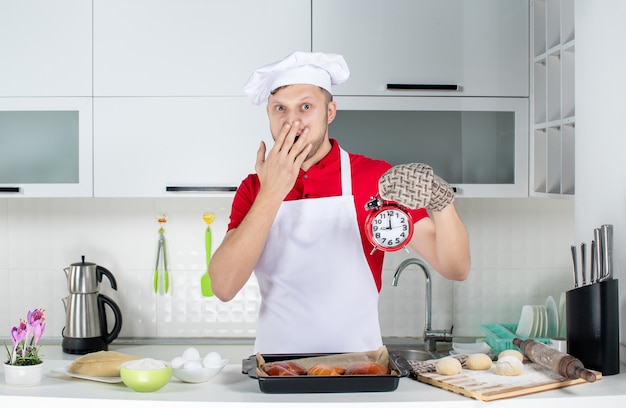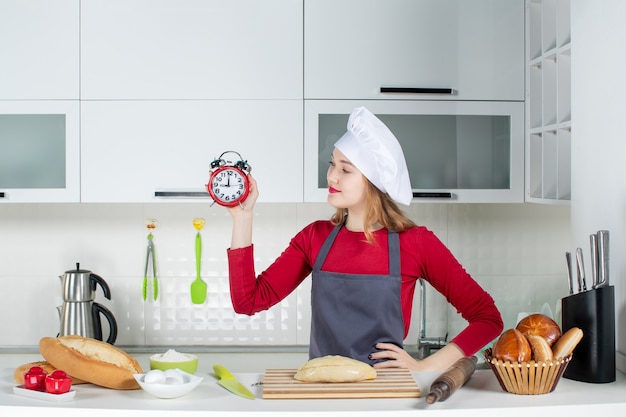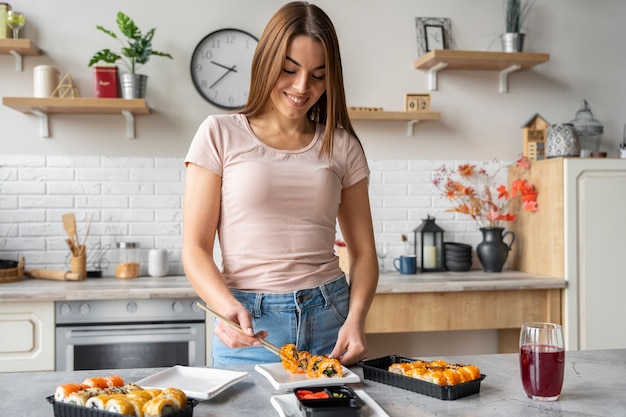Cooking is an art, and like any art, it demands a certain level of precision. Timing, in particular, is the maestro conducting the symphony of flavours in your kitchen. A few minutes too long, and your dish could be dry and disappointing. A few minutes too short, and you might be dealing with a food safety hazard.
I've been cooking for years, and I've made my fair share of mistakes – burnt roasts, raw chicken, soggy pasta – you name it, I've probably done it. But with each culinary mishap, I learned something new, refining my timing and ultimately discovering the secret to kitchen success: a combination of understanding, tools, and a touch of intuition.
So, whether you're a seasoned chef or a kitchen novice, this guide is your roadmap to mastering the art of cooking with impeccable timing.
(Part 1) Understanding the Basics

Before we delve into the nitty-gritty of cooking times, let's lay a solid foundation. Timing is a dance with several partners, and understanding these factors is crucial to avoid any missteps.
1. The Power of the Thermometer
Let's talk about my absolute favourite kitchen tool: the trusty meat thermometer. It's the ultimate weapon against overcooked or undercooked food, and it's a game-changer for achieving perfectly cooked meat, poultry, and fish. This little gadget takes the guesswork out of cooking, ensuring that your food is cooked to the right temperature, no matter how thick or thin it is.
Remember, each cut of meat and type of poultry has a specific internal temperature that signifies doneness. A juicy, medium-rare steak should reach 130°F (54.4°C), while a well-done steak should hit 160°F (71.1°C). A whole chicken is perfectly cooked at 165°F (73.9°C), and a turkey at 165°F (73.9°C). And for fish, the ideal internal temperature ranges from 145°F (62.8°C) to 150°F (65.6°C), depending on the type of fish.
If you're new to using a meat thermometer, don't worry! It's incredibly easy to use. Simply insert the thermometer into the thickest part of the meat, making sure it doesn't touch any bones. Wait a few seconds for the reading to stabilize, and you'll have a precise temperature reading.
2. The Oven's Quirks
Every oven has its own personality. Just because your neighbour's oven bakes a cake perfectly at 350°F (177°C) doesn't mean yours will.
The best way to get acquainted with your oven is to conduct a simple test. Bake a batch of cookies or a simple cake. You'll soon discover if your oven runs hot or cold, allowing you to adjust your cooking times accordingly. For example, if your oven tends to run hot, you might need to lower the temperature by 10 degrees or reduce the cooking time by a few minutes.
3. Size Matters
The size and shape of your food can have a significant impact on cooking times. A small roast chicken will cook faster than a large one, and a thin pizza crust will bake more quickly than a thick, deep-dish one.
Consider these factors when planning your cooking time. You might need to add a few extra minutes for larger pieces of food, or you might need to reduce the cooking time for smaller ones.
4. Altitude's Impact
Here's a fact that might surprise you: The higher you live, the longer it takes for food to cook! That's because air pressure decreases at higher altitudes, slowing down heat transfer.
If you live at a high altitude, you may need to increase your cooking times by 5 to 10%. It's always a good idea to check your recipe for specific recommendations for high-altitude cooking.
(Part 2) Mastering the Art of Timing

Now that we've laid the groundwork, let's explore the specifics of timing for different types of cooking methods.
1. Roasting Perfection
Roasting is a magnificent way to cook large cuts of meat, poultry, and vegetables, creating a beautiful caramelized exterior and succulent, tender interior. But achieving roast perfection requires a touch of finesse.
- Preheat Your Oven: This is non-negotiable for even cooking.
- Pat It Dry: Dry the surface of your meat or poultry with paper towels to encourage browning.
- Use a Roasting Rack: This allows for better air circulation, ensuring even cooking on all sides.
- Don't Overcrowd the Pan: Give your food space to breathe and cook evenly.
- Baste Regularly: Basting with pan juices keeps your roast moist and flavorful.
- Rest It: Let your roast rest for 10-15 minutes after cooking before carving. This allows the juices to redistribute, creating a more tender and flavorful result.
2. Bake It Right
Baking is a classic cooking method, perfect for creating everything from delicate cakes and cookies to hearty breads and casseroles. But baking success requires understanding the intricacies of oven heat and timing.
- Preheat Your Oven: Once again, this is crucial for even baking.
- Use the Right Pan: Different recipes call for specific sized and shaped pans. Sticking to the recipe's instructions is crucial.
- Grease and Flour: This prevents your baked goods from sticking to the pan, ensuring a clean release and beautiful presentation.
- Don't Open the Oven Door: Resist the temptation to peek too early! Opening the oven door can cause the temperature to fluctuate, affecting your baking time.
- Use a Toothpick Test: Insert a toothpick into the center of your baked good. If it comes out clean, it's ready.
3. Boiling with Confidence
Boiling is a simple yet efficient method for cooking pasta, vegetables, and eggs. It requires a little bit of attention, but the results are worth it.
- Use a Large Pot: Ensure there's enough space for the food to cook evenly.
- Bring the Water to a Rolling Boil: This ensures that the food cooks quickly and evenly.
- Add Salt to the Water: Not only does it enhance flavour, but it also raises the boiling point of the water, helping the food cook more quickly.
- Don't Overcrowd the Pot: This can cool down the water and prevent the food from cooking properly.
- Stir Frequently: This prevents the food from sticking to the bottom of the pot.
- Test for Doneness: Use a fork or knife to check for tenderness.
4. Stir-Fry Success
Stir-frying is a fast and flavorful way to cook vegetables, meat, and seafood, making it a favourite for quick and healthy meals. It's a technique that requires precision and speed, but the results are well worth the effort.
- Heat Your Wok: This is essential for creating the "wok hei" flavour, a smoky, caramelized aroma that's characteristic of stir-fries.
- Use High Heat: This helps to sear the food and prevent it from steaming, resulting in a crisp, tender texture.
- Cut Your Ingredients Uniformly: This ensures that everything cooks at the same rate, preventing some ingredients from being overcooked while others remain raw.
- Stir Continuously: This prevents the food from sticking to the bottom of the wok and ensures even cooking.
- Add Sauce Last: This helps to prevent the sauce from burning and allows the flavours to meld together without becoming too thick.
5. Grilling and Barbecuing
Grilling and barbecuing are summer staples, but they can be a little tricky. Mastering these techniques requires understanding the nuances of heat and timing.
- Preheat Your Grill: This ensures that your food cooks evenly and develops beautiful grill marks.
- Oil Your Grill: This prevents the food from sticking, ensuring a clean release and avoiding unwanted burning.
- Use Direct Heat for Quick Cooking: This is best for smaller cuts of meat, vegetables, and fish, resulting in a quick sear and delicious char.
- Use Indirect Heat for Slower Cooking: This is ideal for larger cuts of meat and poultry, allowing them to cook through without burning.
- Flip Once: Flipping your food too often can prevent it from developing those coveted grill marks.
- Use a Meat Thermometer: This is the best way to ensure that your food is cooked to the right temperature, guaranteeing both safety and optimal taste.
(Part 3) Cooking Times for Common Foods

Here's a handy table that provides some general cooking times for common foods. Keep in mind that these are just guidelines, and actual cooking times can vary based on the specific recipe, your oven, and your altitude. Always refer to your recipe for specific instructions and adjust your cooking times accordingly.
| Food | Cooking Time | Internal Temperature (F) |
|---|---|---|
| chicken breasts (boneless, skinless) | 15-20 minutes | 165°F |
| Steak (1-inch thick) | 4-6 minutes per side (medium-rare) | 130°F |
| Salmon (4-ounce fillet) | 12-15 minutes | 145°F |
| Pasta (dried) | 8-12 minutes | N/A |
| Vegetables (most) | 5-10 minutes | N/A |
| Cookies | 8-12 minutes | N/A |
| Cake (9-inch round) | 30-40 minutes | N/A |
(Part 4) kitchen tools for Perfect Timing
Every successful chef has a collection of trusted tools, and certain kitchen essentials play a vital role in achieving impeccable timing.
1. The Meat Thermometer
I've already sung the praises of the meat thermometer, and I can't stress enough how invaluable it is. It eliminates the guesswork, ensuring that your meat, poultry, and fish are cooked to the right temperature, guaranteeing both safety and delicious results.
Invest in a good quality meat thermometer, and you'll be rewarded with consistently perfect results.
2. The Timer
A kitchen timer is a must-have for any cook, especially when you're juggling multiple tasks. It keeps you on track, alerting you when your dishes are ready, preventing overcooking or undercooking.
Choose a timer with a loud, clear alarm that you can hear from across the house, ensuring that you don't miss a beat.
3. The Oven Thermometer
If you're unsure whether your oven is heating to the correct temperature, an oven thermometer is a great investment. It helps you calibrate your oven, ensuring that your food is cooking evenly and consistently.
Even brand new ovens can have temperature variations, so having an oven thermometer allows you to achieve consistently delicious results.
4. The Kitchen Scale
A kitchen scale is essential for accuracy in baking, ensuring that your ingredients are measured precisely. This is especially important for cakes, cookies, and breads, where even a small difference in weight can affect the outcome.
Using a kitchen scale will significantly improve the quality of your baked goods, resulting in consistent, delicious results every time.
(Part 5) Don't Be Afraid to Experiment
Cooking is a journey of discovery. Don't be afraid to try new things and adjust your cooking times to find what works best for you. Over time, you'll develop your own sense of timing and become a confident cook.
Remember, it's about learning from your mistakes and refining your skills. Don't be discouraged by a few mishaps. Embrace them as learning opportunities. A little bit of trial and error is part of the process, and it can lead to unexpected culinary delights.
(Part 6) Trust Your Instincts
While recipes and kitchen tools are invaluable guides, it's also crucial to trust your instincts.
If you think your food might need a few extra minutes of cooking, go for it. Or if you think it's ready sooner than the recipe indicates, check it out.
With experience, you'll develop a feel for your food, a sense of intuition that goes beyond the instructions. Trust your senses, and you'll create dishes that are truly your own.
(Part 7) Embrace the Unexpected
Sometimes, no matter how carefully you follow a recipe, things don't go exactly as planned. That's okay! It's part of the fun of cooking.
A little bit of trial and error can lead to some truly delicious and unexpected results.
One of my most memorable culinary mishaps happened when I was trying to make a new pasta sauce. I accidentally added too much salt! Instead of throwing it out, I decided to try to salvage the situation by adding a few tablespoons of sugar and some fresh lemon juice. It worked! The sauce ended up being incredibly delicious and unique, a testament to the creativity that can arise from unexpected culinary turns.
(Part 8) Enjoy the Process
Don't forget to enjoy the process! Cooking should be a fun and rewarding experience.
I love the feeling of accomplishment that comes from creating a delicious meal from scratch. And I especially love sharing my meals with friends and family, enjoying the satisfaction of seeing them savor my creations.
So, whether you're a seasoned chef or a kitchen novice, remember that practice makes perfect. The more you cook, the more comfortable you'll become with timing, and the more confident you'll feel in your kitchen.
FAQs
1. What if I overcook my food?
If you've overcooked your food, don't despair! Depending on the dish, there might still be ways to salvage it. For example, if you've overcooked a roast, you can try shredding it and using it in a sandwich or a casserole. Or, if you've overcooked vegetables, you can add them to a soup or stew.
2. What if I undercook my food?
Undercooked food can be a health hazard, so it's essential to cook it properly. If you've undercooked meat, poultry, or fish, you'll need to cook it again until it reaches the correct internal temperature.
3. How do I know if my food is done?
The best way to tell if your food is done is to use a meat thermometer, especially for meat and poultry. However, there are also other signs to look for, such as color changes, texture changes, and the way the food releases juices.
4. What if I don't have a meat thermometer?
If you don't have a meat thermometer, you can use other methods to judge the doneness of your food. For example, you can check the color of the meat or poultry, or you can press on it to see how firm it is. However, it's always best to err on the side of caution and cook your food thoroughly, especially when it comes to meat and poultry.
5. What are some good tips for beginners?
Here are a few tips to help you embark on your culinary journey:
- Start with simple recipes. There are many beginner-friendly recipes available online and in cookbooks. Choose recipes that don't have too many steps or complicated techniques.
- Use fresh, high-quality ingredients. This makes a big difference in the taste of your food. Choose ingredients that are in season, and don't be afraid to experiment with different flavours and combinations.
- Don't be afraid to experiment. Try new things and see what you like. Cooking is about exploring different flavours and techniques.
- Practice makes perfect. The more you cook, the better you'll become. Don't be discouraged if your first attempts aren't perfect. Keep practicing, and you'll soon develop your own culinary style.
Everyone is watching

How to Cook Frozen Lobster Tails Perfectly: A Step-by-Step Guide
RecipesLobster. Just the word conjures up images of lavish meals, special occasions, and a taste of luxury. But let's...

Pigs in a Blanket Cooking Time: How Long to Bake for Perfect Results
RecipesAh, pigs in a blanket. Just the name conjures up images of those delightful little parcels of crispy pastry en...

Pork Fillet Cooking Time: How Long to Cook It Perfectly
RecipesPork fillet, or tenderloin as it's sometimes called, is a real favourite in our house. It's so versatile, and...

The Ultimate Guide to Cooking Delicious Frankfurters
RecipesLet's face it, we all love a good frankfurter. It's a classic, simple, and always satisfying. But let's be rea...

The Ultimate Guide to Tender, Juicy Pulled Pork
RecipesRight, let's talk pulled pork. It's one of those dishes that just screams "comfort food," doesn't it? I mean...
